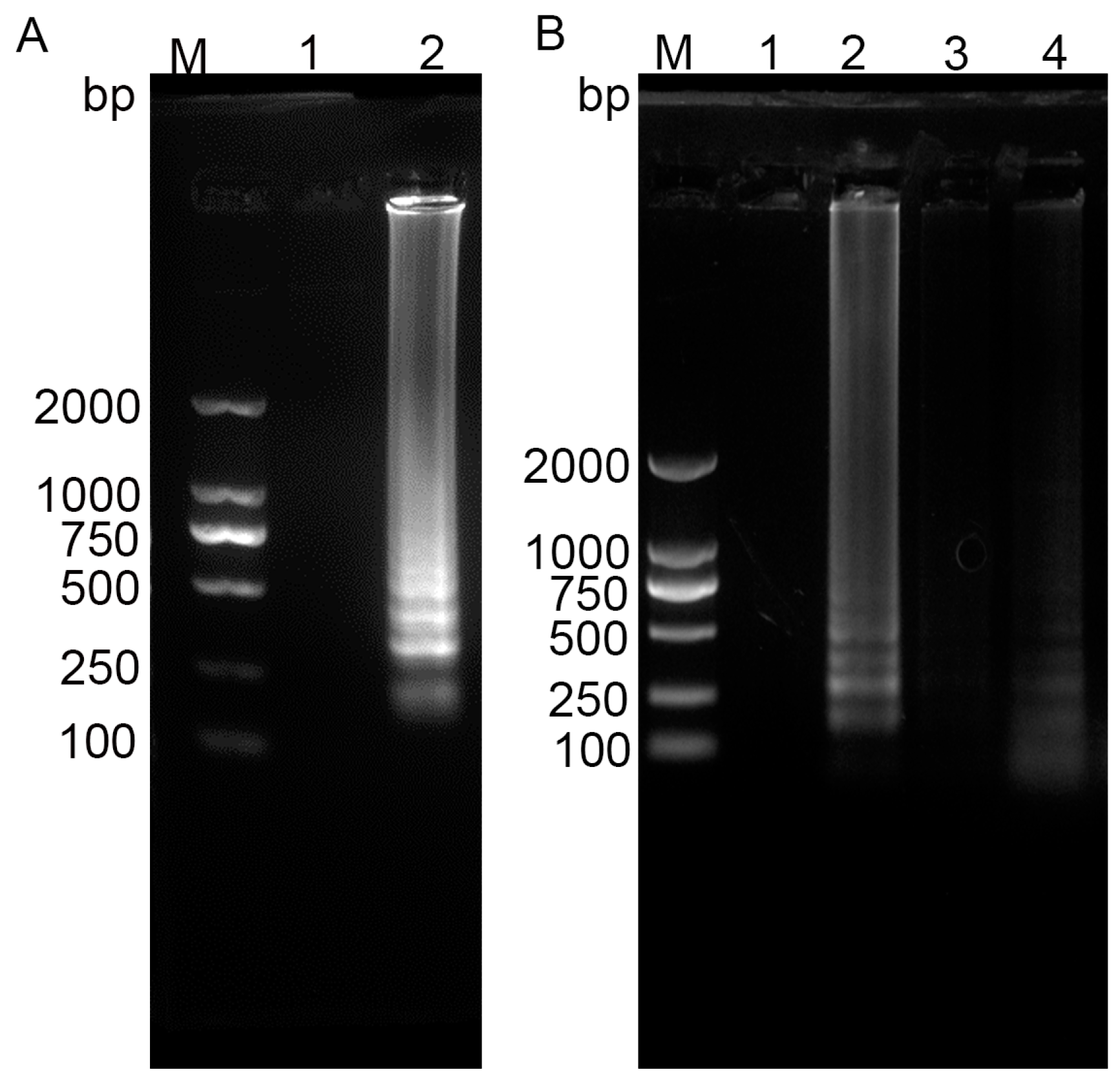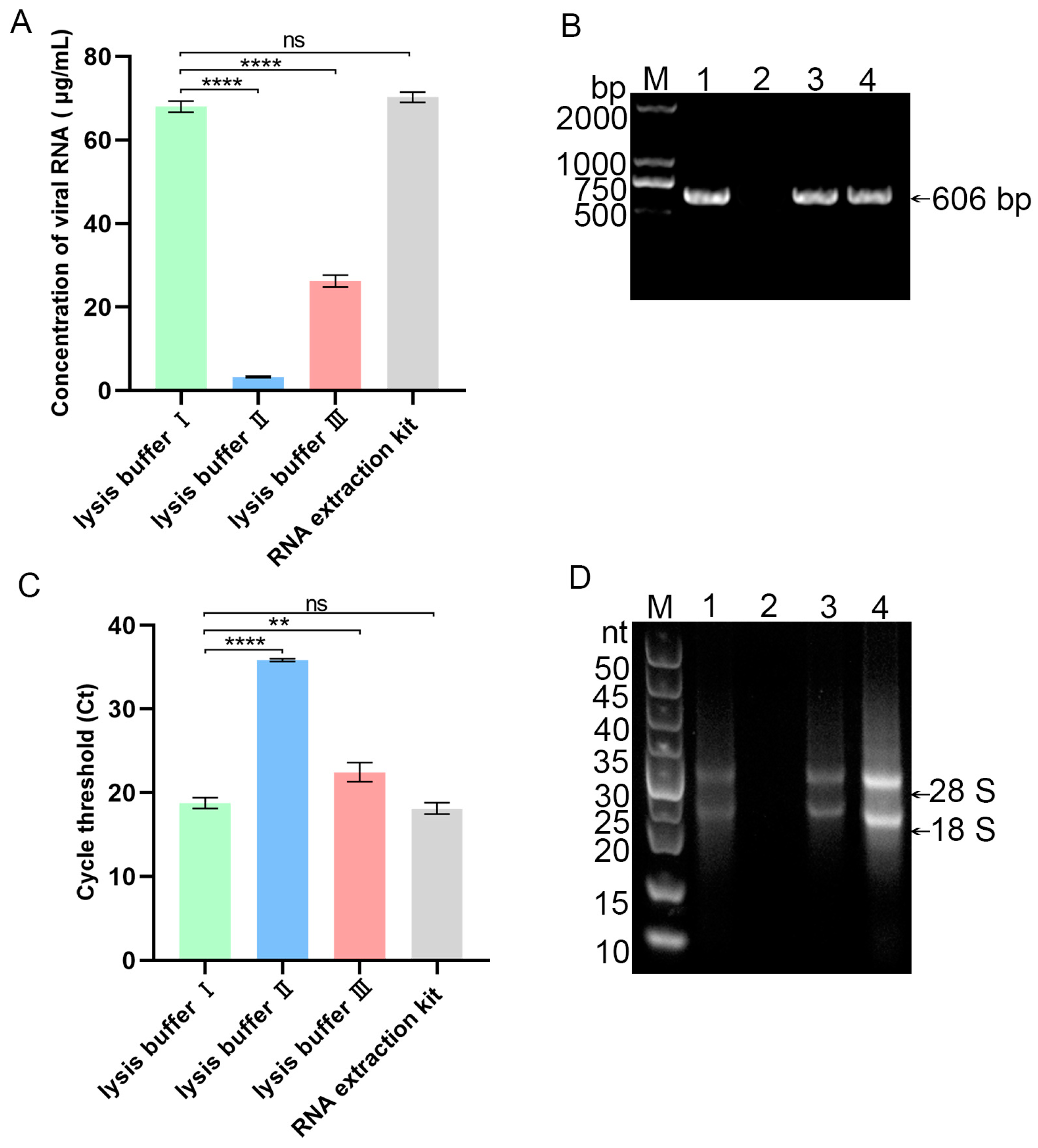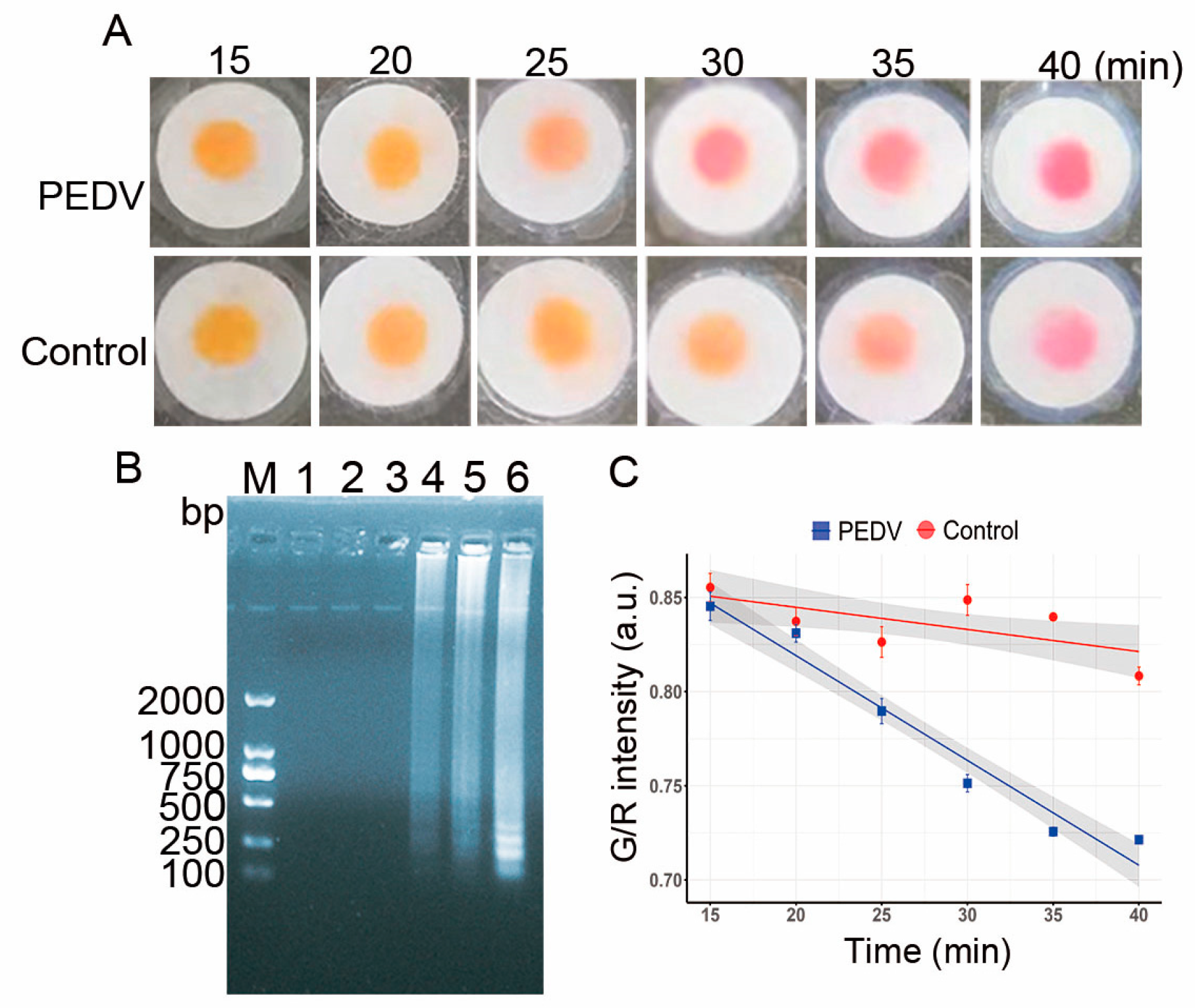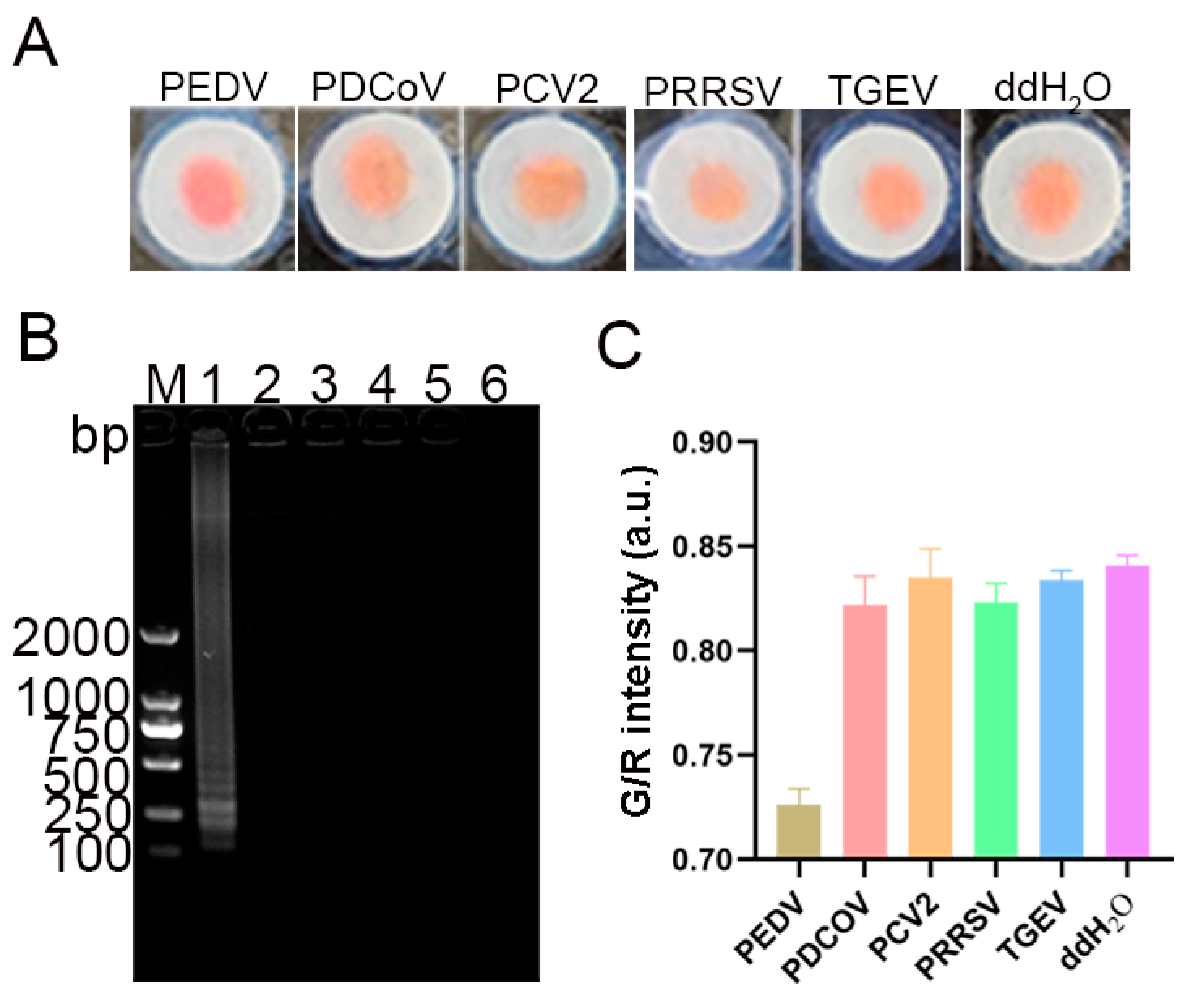Development of a Paper-Based Microfluidic Chip for Point-of-Care Detection of PEDV
Simple Summary
Abstract
1. Introduction
2. Materials and Methods
2.1. Materials, Reagents and Instruments
2.2. Optimization of RT-LAMP Reaction System
2.3. Fabrication of the μPAD
2.4. Selection of Paper Substrate
2.5. Optimization of Viral Nucleic Acid Lysis Buffer
2.6. Optimization of the Chromatography Channel and Nucleic Acid Amplification Zone Geometry
2.7. Optimization of Indicator
2.8. Detection Procedure of the LAMP-μPAD
2.9. Image Processing of the LAMP-μPAD Assay
2.10. Determination of Diagnostic Cut-Off Values and Performance Evaluation of the LAMP-μPAD Assay
2.11. Clinical Implementation of the LAMP-μPAD Assay for PEDV Detection
2.12. Statistical Analysis
3. Results
3.1. Development of RT-LAMP Reaction System
3.2. Selection of Paper Substrates
3.3. Screening of Nucleic Acid Lysis Buffer
3.4. Optimization of the Channel and Nucleic Acid Amplification Zone Geometry
3.5. Selection of Colorimetric Indicators for the LAMP-μPAD Assay
3.6. Cut-Off Value and Diagnostic Performance Evaluation of the LAMP-μPAD Assay
3.7. Reaction Time for the LAMP-μPAD Assay
3.8. Specificity and Sensitivity of the LAMP-μPAD Assay
3.9. Application of the LAMP-μPAD in Clinical Validation
4. Discussion
5. Conclusions
Supplementary Materials
Author Contributions
Funding
Institutional Review Board Statement
Informed Consent Statement
Data Availability Statement
Acknowledgments
Conflicts of Interest
References
- Pensaert Mb Fau-de Bouck, P.; de Bouck, P. A New Coronavirus-like Particle Associated with Diarrhea in Swine. Arch. Virol. 1978, 58, 243–247. [Google Scholar] [CrossRef] [PubMed]
- Luo, H.; Liang, Z.; Lin, J.; Wang, Y.; Liu, Y.; Mei, K.; Zhao, M.; Huang, S. Research progress of porcine epidemic diarrhea virus S protein. Front. Microbiol. 2024, 15, 1396894. [Google Scholar] [CrossRef]
- Wood, E.N. An apparently new syndrome of porcine epidemic diarrhoea. Vet. Rec. 1977, 100, 243–244. [Google Scholar] [CrossRef]
- Zhang, Y.; Chen, Y.; Zhou, J.; Wang, X.; Ma, L.; Li, J.; Yang, L.; Yuan, H.; Pang, D.; Ouyang, H. Porcine Epidemic Diarrhea Virus: An Updated Overview of Virus Epidemiology, Virulence Variation Patterns and Virus–Host Interactions. Viruses 2022, 14, 2434. [Google Scholar] [CrossRef] [PubMed]
- Fu, Y.; Li, B.; Liu, G. Rapid and efficient detection methods of pathogenic swine enteric coronaviruses. Appl. Microbiol. Biotechnol. 2020, 104, 6091–6100. [Google Scholar] [CrossRef]
- Sun, Y.; Gong, T.; Wu, D.; Feng, Y.; Gao, Q.; Xing, J.; Zheng, X.; Song, Z.; Liu, X.; Chen, X.; et al. Isolation, Identification, and Pathogenicity of Porcine Epidemic Diarrhea Virus. Front. Microbiol. 2023, 14, 1273589. [Google Scholar] [CrossRef]
- Olech, M. Current State of Molecular and Serological Methods for Detection of Porcine Epidemic Diarrhea Virus. Pathogens 2022, 11, 1074. [Google Scholar] [CrossRef]
- Padzil, F.; Mariatulqabtiah, A.R.; Tan, W.S.; Ho, K.L.; Isa, N.M.; Lau, H.Y.; Abu, J.; Chuang, K.-P. Loop-Mediated Isothermal Amplification (LAMP) as a Promising Point-of-Care Diagnostic Strategy in Avian Virus Research. Animals 2021, 12, 76. [Google Scholar] [CrossRef] [PubMed]
- Fang, M.; Wang, Y.; Yang, T.A.-O.; Zhang, J.; Yu, H.; Luo, Z.A.-O.; Su, B.A.-O.; Lin, X.A.-O. Nucleic acid plate culture: Label-free and naked-eye-based digital loop-mediated isothermal amplification in hydrogel with machine learning. ACS Sens. 2024, 9, 2010–2019. [Google Scholar] [CrossRef]
- Seyrig, G.; Stedtfeld, R.D.; Tourlousse, D.M.; Ahmad, F.; Towery, K.; Cupples, A.M.; Tiedje, J.M.; Hashsham, S.A. Selection of fluorescent DNA dyes for real-time LAMP with portable and simple optics. J. Microbiol. Methods 2015, 119, 223–227. [Google Scholar] [CrossRef]
- Xiong, J.A.-O.; Huang, B.; Xu, J.S.; Huang, W.S. A closed-tube loop-mediated isothermal amplification assay for the visual detection of staphylococcus aureus. Appl. Biochem. Biotechnol. 2020, 191, 201–211. [Google Scholar] [CrossRef]
- Allgöwer, S.M.; Hartmann, C.A.; Lipinski, C.; Mahler, V.; Randow, S.; Völker, E.; Holzhauser, T.A.-O. LAMP-LFD Based on Isothermal Amplification of Multicopy Gene Orf160b: Applicability for Highly Sensitive Low-Tech Screening of Allergenic Soybean (Glycine Max) in Food. Foods 2020, 9, 1741. [Google Scholar] [CrossRef] [PubMed]
- Quyen, T.L.; Vinayaka, A.A.-O.; Golabi, M.; Nguyen, T.; Ngoc, H.V.; Bang, D.D.; Wolff, A.A.-O. Multiplexed detection of pathogens using solid-phase loop-mediated isothermal amplification on a supercritical angle fluorescence array for point-of-care applications. ACS Sens. 2022, 7, 3343–3351. [Google Scholar] [CrossRef]
- Choopara, I.; Suea-Ngam, A.A.-O.; Teethaisong, Y.; Howes, P.A.-O.; Schmelcher, M.; Leelahavanichkul, A.; Thunyaharn, S.; Wongsawaeng, D.; deMello, A.J.; Dean, D.; et al. Fluorometric paper-based, loop-mediated isothermal amplification devices for quantitative point-of-care detection of methicillin-resistant staphylococcus aureus (MRSA). ACS Sens. 2021, 6, 742–751. [Google Scholar] [CrossRef] [PubMed]
- Tong, X.; Lin, X.A.-O.; Duan, N.; Wang, Z.; Wu, S.A.-O. Laser-printed paper-based microfluidic chip based on a multicolor fluorescence carbon dot biosensor for visual determination of multiantibiotics in aquatic products. ACS Sens. 2022, 7, 3947–3955. [Google Scholar] [CrossRef]
- Chaumpluk, P.; Suriyasomboon, A. A Simple Paper-Based Lab-on-a-Chip for the Detection of a Highly Pathogenic Strain of Porcine Reproductive and Respiratory Syndrome Virus. Aust. J. Chem. 2014, 67, 1434–1440. [Google Scholar] [CrossRef]
- Huang, L.; Xiao, W.; Xu, T.; Chen, H.; Jin, Z.; Zhang, Z.; Song, Q.; Tang, Y. Miniaturized paper-based smartphone biosensor for differential diagnosis of wild-type pseudorabies virus infection versus vaccination immunization. Sens. Actuators B-Chem. 2021, 327, 128893. [Google Scholar] [CrossRef]
- Rodriguez, N.M.; Wong, W.S.; Liu, L.; Dewar, R.; Klapperich, C.M. A Fully Integrated Paperfluidic Molecular Diagnostic Chip for the Extraction, Amplification, and Detection of Nucleic Acids from Clinical Samples. Lab Chip 2016, 16, 753–763. [Google Scholar] [CrossRef] [PubMed]
- Kim, S.; Akarapipad, P.; Nguyen, B.T.; Breshears, L.E.; Sosnowski, K.; Baker, J.; Uhrlaub, J.L.; Nikolich-Žugich, J.; Yoon, J.-Y. Direct Capture and Smartphone Quantification of Airborne SARS-CoV-2 on a Paper Microfluidic Chip. Biosens. Bioelectron. 2022, 200, 113912. [Google Scholar] [CrossRef]
- Yin, K.; Ding, X.; Li, Z.; Sfeir, M.M.; Ballesteros, E.; Liu, C. Autonomous Lab-on-Paper for Multiplexed, CRISPR-Based Diagnostics of SARS-CoV-2. Lab Chip 2021, 21, 2730–2737. [Google Scholar] [CrossRef]
- Kaarj, K.; Akarapipad, P.; Yoon, J.-Y. Simpler, faster, and sensitive Zika virus assay using smartphone detection of loop-mediated isothermal amplification on paper microfluidic chips. Sci. Rep. 2018, 8, 12438. [Google Scholar] [CrossRef] [PubMed]
- Kamel, M.; Davidson, J.L.; Schober, J.M.; Fraley, G.S.; Verma, M.S. A Paper-Based Loop-Mediated Isothermal Amplification Assay for Highly Pathogenic Avian Influenza. Sci. Rep. 2025, 15, 12110. [Google Scholar] [CrossRef]
- Dong, T.; Qin, L.; Wang, Z.; Fan, C.; Shen, C.; Feng, P.; Kong, Q.; Ke, B.; Ying, B.; Li, F. Point-of-Care Diagnosis of Tuberculosis Using a Portable Nucleic Acid Test with Distance-Based Readout. Anal. Chem. 2024, 96, 20204–20212. [Google Scholar] [CrossRef]
- Li, R.; Cao, W.; Yuan, J.; Li, L.; Zhou, Y.; Wang, F.; Wang, Z.; Tian, X. Development of a Visual Detection Method of Porcine Deltacoronavirus Using Loop-Mediated Isothermal Amplification. Front. Microbiol. 2024, 15, 1465923. [Google Scholar] [CrossRef] [PubMed]
- Landis, J.R.; Koch, G.G. The Measurement of Observer Agreement for Categorical Data. Biometrics 1977, 33, 159–174. [Google Scholar] [CrossRef] [PubMed]
- Zhang, F.; Luo, Y.; Lin, C.; Tan, M.; Wan, P.; Xie, B.; Xiong, L.; Ji, H. Epidemiological Monitoring and Genetic Variation Analysis of Pathogens Associated with Porcine Viral Diarrhea in Southern China from 2021 to 2023. Front. Microbiol. 2024, 15, 1303915. [Google Scholar] [CrossRef]
- Niederwerder, M.C.; Hesse, R.A. Swine Enteric Coronavirus Disease: A Review of 4 Years with Porcine Epidemic Diarrhoea Virus and Porcine Deltacoronavirus in the United States and Canada. Transbound. Emerg. Dis. 2018, 65, 660–675. [Google Scholar] [CrossRef]
- Ma, L.; Lian, K.; Zhu, M.; Tang, Y.; Zhang, M. Visual Detection of Porcine Epidemic Diarrhea Virus by Recombinase Polymerase Amplification Combined with Lateral Flow Dipstrip. BMC Vet. Res. 2022, 18, 140. [Google Scholar] [CrossRef]
- El-Tholoth, M.; Bai, H.; Mauk, M.G.; Saif, L.; Bau, H.H. A Portable, 3D Printed, Microfluidic Device for Multiplexed, Real Time, Molecular Detection of the Porcine Epidemic Diarrhea Virus, Transmissible Gastroenteritis Virus, and Porcine Deltacoronavirus at the Point of Need. Lab Chip 2021, 21, 1118–1130. [Google Scholar] [CrossRef]
- Anushka; Bandopadhyay, A.; Das, P.K. Paper Based Microfluidic Devices: A Review of Fabrication Techniques and Applications. Eur. Phys. J. Spec. Top. 2023, 232, 781–815. [Google Scholar] [CrossRef]
- Tong, X.; Ga, L.; Zhao, R.; Ai, J. Research Progress on the Applications of Paper Chips. RSC Adv. 2021, 11, 8793–8820. [Google Scholar] [CrossRef] [PubMed]
- Noviana, E.; Ozer, T.; Carrell, C.S.; Link, J.S.; McMahon, C.; Jang, I.; Henry, C.S. Microfluidic Paper-Based Analytical Devices: From Design to Applications. Chem. Rev. 2021, 121, 11835–11885. [Google Scholar] [CrossRef]
- Reynolds, J.; Loeffler, R.S.; Leigh, P.J.; Lopez, H.A.; Yoon, J.-Y. Recent Uses of Paper Microfluidics in Isothermal Nucleic Acid Amplification Tests. Biosensors 2023, 13, 885. [Google Scholar] [CrossRef] [PubMed]
- Mei, J.; Wang, D.; Zhang, Y.; Wu, D.; Cui, J.; Gan, M.; Liu, P. Portable Paper-based Nucleic Acid Enrichment for Field Testing. Adv. Sci. 2023, 10, 2205217. [Google Scholar] [CrossRef] [PubMed]
- Thuo, M.M.; Martinez, R.V.; Lan, W.-J.; Liu, X.; Barber, J.; Atkinson, M.B.J.; Bandarage, D.; Bloch, J.-F.; Whitesides, G.M. Fabrication of Low-Cost Paper-Based Microfluidic Devices by Embossing or Cut-and-Stack Methods. Chem. Mater. 2014, 26, 4230–4237. [Google Scholar] [CrossRef]
- Kumawat, N.; Soman, S.S.; Vijayavenkataraman, S.; Kumar, S. Rapid and Inexpensive Process to Fabricate Paper Based Microfluidic Devices Using a Cut and Heat Plastic Lamination Process. Lab Chip 2022, 22, 3377–3389. [Google Scholar] [CrossRef]










| RT-PCR | Total | |||
|---|---|---|---|---|
| Positive | Negative | |||
| LAMP-μPAD | Positive | 41 | 0 | 41 |
| Negative | 2 | 89 | 91 | |
| Total | 43 | 89 | 132 | |
Disclaimer/Publisher’s Note: The statements, opinions and data contained in all publications are solely those of the individual author(s) and contributor(s) and not of MDPI and/or the editor(s). MDPI and/or the editor(s) disclaim responsibility for any injury to people or property resulting from any ideas, methods, instructions or products referred to in the content. |
© 2025 by the authors. Licensee MDPI, Basel, Switzerland. This article is an open access article distributed under the terms and conditions of the Creative Commons Attribution (CC BY) license (https://creativecommons.org/licenses/by/4.0/).
Share and Cite
Li, R.; Tian, X.; Cao, W.; Jiang, J.; Yuan, J.; Li, L.; You, Y.; Zhou, Y.; Wang, Z.; Wang, F. Development of a Paper-Based Microfluidic Chip for Point-of-Care Detection of PEDV. Vet. Sci. 2025, 12, 427. https://doi.org/10.3390/vetsci12050427
Li R, Tian X, Cao W, Jiang J, Yuan J, Li L, You Y, Zhou Y, Wang Z, Wang F. Development of a Paper-Based Microfluidic Chip for Point-of-Care Detection of PEDV. Veterinary Sciences. 2025; 12(5):427. https://doi.org/10.3390/vetsci12050427
Chicago/Turabian StyleLi, Renfeng, Xiangqin Tian, Wenyan Cao, Jiaxin Jiang, Jiakang Yuan, Linyue Li, Yonghe You, Yanlin Zhou, Ziliang Wang, and Fangyu Wang. 2025. "Development of a Paper-Based Microfluidic Chip for Point-of-Care Detection of PEDV" Veterinary Sciences 12, no. 5: 427. https://doi.org/10.3390/vetsci12050427
APA StyleLi, R., Tian, X., Cao, W., Jiang, J., Yuan, J., Li, L., You, Y., Zhou, Y., Wang, Z., & Wang, F. (2025). Development of a Paper-Based Microfluidic Chip for Point-of-Care Detection of PEDV. Veterinary Sciences, 12(5), 427. https://doi.org/10.3390/vetsci12050427








